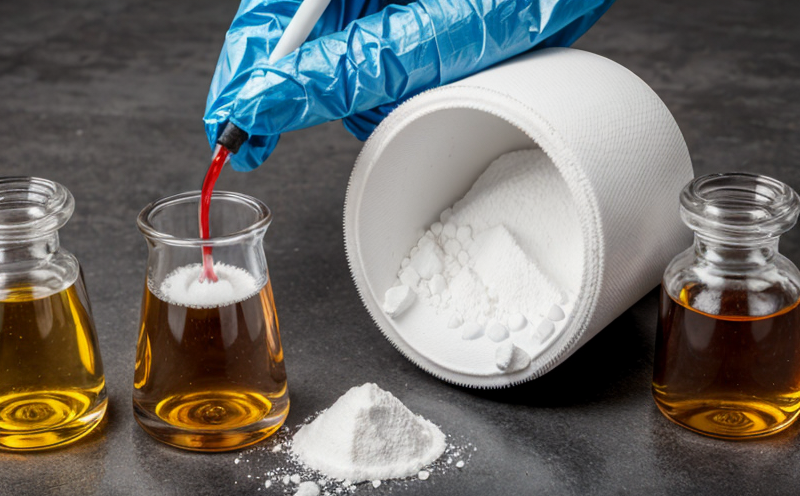IEC 62321 Hazardous Substance Testing for Electrical and Electronic Products
The IEC 62321 standard is a crucial guideline in the electronics industry, designed to ensure that electrical and electronic products are free from hazardous substances. This standard plays an essential role in promoting environmental protection by minimizing the use of harmful chemicals during the manufacturing process.
IEC 62321 covers various stages of product development and manufacturing, including material selection, design, production, and disposal. Compliance with this standard helps manufacturers meet regulatory requirements set forth by international bodies like REACH, RoHS, and WEEE. The IEC 62321 test ensures that the products do not contain harmful substances such as lead (Pb), mercury (Hg), cadmium (Cd), hexavalent chromium (Cr(VI)), polybrominated biphenyls (PBPs), and polybrominated diphenylethers (PBDEs).
The testing process involves several critical steps. First, the product must undergo a comprehensive materials analysis to identify all components used in its construction. Next, specific samples are extracted from these components for detailed chemical analysis. This analysis is conducted using advanced spectroscopic techniques such as Inductively Coupled Plasma Mass Spectrometry (ICP-MS) and Gas Chromatography-Mass Spectrometry (GC-MS). The results of this analysis provide precise concentrations of the targeted hazardous substances.
Once the test results are available, they are compared against the thresholds specified in IEC 62321. If any substance exceeds these limits, corrective actions must be taken to redesign or reengineer parts of the product. This process ensures that manufacturers adhere strictly to international standards and maintain a high level of environmental responsibility.
The importance of this testing cannot be overstated; it directly impacts both human health and the environment. Exposure to certain hazardous substances has been linked to various adverse effects, including cancer, neurological disorders, reproductive issues, and developmental problems in children. By adhering to IEC 62321, manufacturers contribute positively towards reducing these risks.
Implementing this standard also enhances brand reputation by demonstrating a commitment to sustainability and corporate social responsibility. Consumers increasingly demand eco-friendly products, making compliance with such standards not just mandatory but beneficial for business growth as well.
| Substance | Threshold (mg/kg) |
|---|---|
| Pb (Lead) | 1000 |
| Hg (Mercury) | 1000 |
| Cd (Cadmium) | 100 |
| PbO2 (Hexavalent Chromium) | 3000 |
| PBBs (Polybrominated Biphenyls) | 5000 |
| PBDTs (Polybrominated Diphenylethers) | 2500 |
It is essential to note that while IEC 62321 primarily focuses on eliminating hazardous substances, it does not provide specific guidance regarding the use of alternative materials. However, compliance with this standard often leads manufacturers towards selecting safer alternatives.
In summary, conducting IEC 62321 testing ensures that electrical and electronic products comply with international standards concerning hazardous substance content. This compliance protects both users from potential health risks and contributes to environmental sustainability efforts worldwide.
Benefits
- Ensures strict adherence to global regulations like REACH, RoHS, and WEEE
- Promotes a safer working environment for manufacturing personnel
- Reduces the risk of product recalls due to non-compliance issues
- Increases consumer trust through transparent environmental practices
- Supports long-term brand loyalty by aligning with sustainability goals
- Facilitates easier market access in countries requiring these standards
- Potential cost savings from avoided fines and penalties for non-compliance
- Aids in maintaining a positive public image, enhancing corporate reputation
The benefits of IEC 62321 compliance extend beyond mere regulatory adherence; they encompass broader strategic advantages that contribute to overall business success.
Eurolab Advantages
At Eurolab, we pride ourselves on delivering unparalleled quality and reliability in our services. Our expertise lies not only in executing rigorous IEC 62321 testing but also in providing comprehensive support throughout the entire process.
- State-of-the-art facilities equipped with cutting-edge analytical instruments
- A team of highly skilled chemists and engineers specializing in environmental compliance
- Access to a wide range of reference materials for accurate comparisons
- Prompt turnaround times ensuring minimal disruption to your workflow
- Comprehensive reporting tailored to individual needs, including detailed chemical profiles
- Confidentiality guarantees protecting proprietary information during testing
- Continuous training and development programs for our staff ensuring up-to-date knowledge of relevant standards
- A commitment to sustainability practices within the laboratory environment itself
With Eurolab, you can rest assured that your products are being tested against some of the most stringent criteria available. Our services go beyond mere compliance; they enhance product quality and promote responsible manufacturing practices.
Use Cases and Application Examples
- Consumer Electronics: Testing ensures that devices like smartphones, laptops, and televisions comply with environmental regulations.
- Medical Devices: Compliance prevents potential health hazards associated with certain materials used in medical equipment.
- Automotive Industry: Ensures adherence to stringent safety standards for vehicle components.
- Solar Panels & Photovoltaic Cells: Guarantees environmental friendliness by ensuring no harmful substances are present.
- Smart Home Devices: Validates that home automation products meet ecological requirements.





